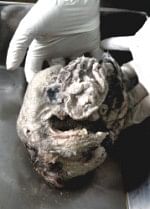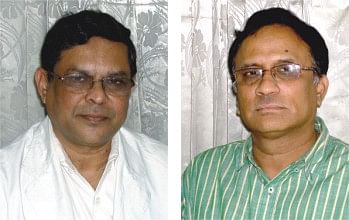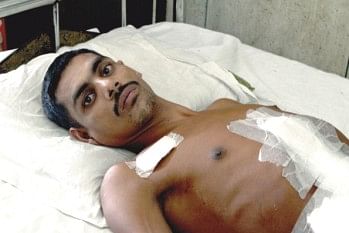| Home - Back Issues - The Team - Contact Us |
 |
| Volume 10 |Issue 21 | June 03, 2011 | |
|
|
Science Dissecting The Unusual ANIKA HOSSAIN
Abdul Malek had been suffering from severe abdominal pain for the past few years. He was born with a disproportionate, swollen upper body and the swelling increased, as he grew older. His parents and the villagers in Bogra paid no attention to his distorted body and he grew up suffering from malnutrition and mental impairment. When his pain became unbearable, Malek was rushed to the Bogra Medical College where he was diagnosed with a tumour in his abdomen and was subsequently brought to Dhaka for treatment by his family members. As the treatment process commenced, the doctors at the Bangabandhu Sheikh Mujib Medical University (BSMMU) discovered that Malek, for the past forty years, has been carrying the fetus of his twin in his upper abdomen. This news soon made the headlines and spread like wildfire. People everywhere started speculating about the cause of this phenomenon, some claiming it was an unnatural pregnancy while others confidently blaming it on demonic activity. Many started pondering about whether the laws of nature were finally changing to make men carry an equal burden in the reproduction process --but that turned out to be wishful thinking. The surgery was completed and the doctors at BSMMU removed the fetus, which weighs 5 kilograms and has distinctive human features such as long black hair, fingers and bones and bears the shape of a partially formed baby. “But this is not a baby,” says professor (Dr) Syed Serajul Karim, the Chairman of the surgery board at BSMMU and one of the doctors who performed the procedure. “We must remember that it is not alive. It is not human. It is just a tumour with some human features,” he enlightens us.
According to Dr Karim, Malek, contrary to popular belief was not pregnant. His condition may have been caused by two physiological reasons. One being the development of a tumour known as teratoma, which looks like a malformed fetus. “Our body has germ cells which have the potentiality to form a part of the human body. Infact, they have the capability to develop a whole human body,” says Karim. The teratoma is just a group of cells which can develop skin, teeth etc, but in essence is just an abnormal growth. If it develops the shape of a fetus it may be called a mature cystic teratoma. The second reason could be a rare condition, which occurs during a monozygotic (single cell) pregnancy, in which one fetus is trapped inside its twin while inside the womb. “Sometimes you'll hear about identical twins being conjoined in the womb and born that way,” says Karim, “ Sometimes they are joined at the head or the shoulders or hips, there are many such cases. This happens because when an embryo develops, it is formed on a plate, in later stages, this plate folds to form a tube. In case of identical twins there are two tubes sharing the same placenta. If these tubes get stuck together, then the twin embryos also get stuck together. However, if one tube goes inside the other, the host twin will develop fetus in fetu,” explains Karim. When one embryo enters the other, it becomes a parasite inside the host embryo. Since this parasite still has the characteristics of an embryo, it will take the partial shape of a human being and grow that way, tapping into the host twin's blood supply. It will get nutrition from the host body but will grow like a tumour. It will not have a brain or vital organs such as a heart, liver or lungs. If the fetus grows, it can cause great pain to its carrier. Sometimes, the host may absorb more than one fetus. In some cases, there may not be enough medical substantiation to determine whether the condition is caused by a teratoma or fetus in fetu. Under these circumstances, if the fetus has some evidence of a vertebral column, it is considered to be a case of fetus in fetu. This phenomenon has been reported twice before in Bangladesh, once in 2005 and again in 2006 and there are about 90 reported cases of fetus in fetu around the world. Cases have been reported in places like India, Philippines, Kazakhstan, Indonesia, USA, Pakistan and China. “The symptoms can be seen from a young age,” says professor (Dr) Zulfiqur Rahman Khan, the surgeon who removed a fetus in 2006. “A lump will form where the tumour is-- this can be in the abdomen or the chest, brain, anywhere. Some of these tumours have limbs, some may even have facial features. The fetus I removed in 2006 had a tongue and teeth,” he shares. Although the host will suffer from severe pain, this condition is not life threatening. “There is no damage done to the carrier,” says Dr Karim. “It grows like a parasite and the longer you leave it there it will grow enormous, so other than body distortion, there is no damage. It will not kill the host body. It is benign and cannot develop into a cancerous tumour. If the tumour is on the stomach, it may create pressure and that could lead to chronic malnutrition but that is just in some cases,” he elaborates. In most of these cases, this condition is caught during the carrier's childhood but there have been a few when the hosts are in their 30s and 40s. This happens in countries like Bangladesh due to lack of education and awareness of the people and due to the lack of proper medical facilities. Malek's family abandoned him during his treatment process, perhaps because of the social stigma involved with his condition. Fortunately for Malek, a good samaritan, who came to visit him after seeing his story on the news, took pity on him and decided to stay with him in order to help him out. This man, Shahalam Sheikh from Tongipara, Gopalganj has been bearing all the costs of Malek's treatment and looking after his needs. “He has been feeling much better after the surgery,” says Sheikh, “I hope to take him home sometime within the next two weeks and I hope his family members will take care of him when I do,” he shares. More than two thousand people have responded to Sheikh's advertisement for blood donation for Malek. This condition can be quite traumatic for the person suffering from it. Those of you out there getting paranoid about carrying a fetus inside you, please calm down. This is an extremely rare condition, which happens at 1 in every 500,000 births and even if you do have it, chances are, you'll be completely fine after the tumour is removed. It is important for everyone to be aware of it however, and treat the persons affected with respect and empathy.
Copyright (R) thedailystar.net 2011 |
||||||||||


